JEEP GRAND CHEROKEE 2010 Owner handbook (in English)
Manufacturer: JEEP, Model Year: 2010, Model line: GRAND CHEROKEE, Model: JEEP GRAND CHEROKEE 2010Pages: 350, PDF Size: 4.58 MB
Page 231 of 350
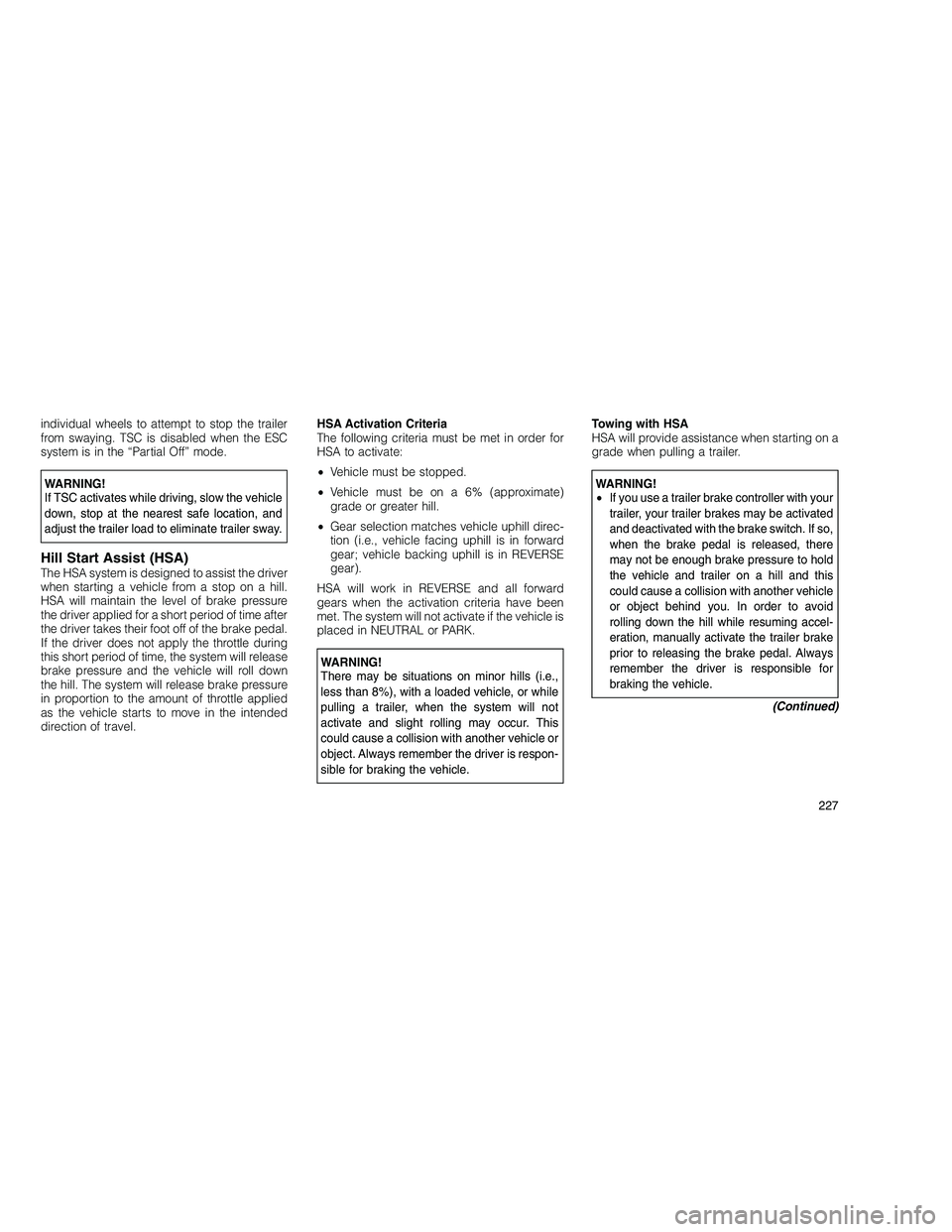
individual wheels to attempt to stop the trailer
from swaying. TSC is disabled when the ESC
system is in the “Partial Off” mode.
WARNING!
If TSC activates while driving, slow the vehicle
down, stop at the nearest safe location, and
adjust the trailer load to eliminate trailer sway.
Hill Start Assist (HSA)The HSA system is designed to assist the driver
when starting a vehicle from a stop on a hill.
HSA will maintain the level of brake pressure
the driver applied for a short period of time after
the driver takes their foot off of the brake pedal.
If the driver does not apply the throttle during
this short period of time, the system will release
brake pressure and the vehicle will roll down
the hill. The system will release brake pressure
in proportion to the amount of throttle applied
as the vehicle starts to move in the intended
direction of travel.HSA Activation Criteria
The following criteria must be met in order for
HSA to activate:
•
Vehicle must be stopped.
• Vehicle must be on a 6% (approximate)
grade or greater hill.
• Gear selection matches vehicle uphill direc-
tion (i.e., vehicle facing uphill is in forward
gear; vehicle backing uphill is in REVERSE
gear).
HSA will work in REVERSE and all forward
gears when the activation criteria have been
met. The system will not activate if the vehicle is
placed in NEUTRAL or PARK.
WARNING!
There may be situations on minor hills (i.e.,
less than 8%), with a loaded vehicle, or while
pulling a trailer, when the system will not
activate and slight rolling may occur. This
could cause a collision with another vehicle or
object. Always remember the driver is respon-
sible for braking the vehicle. Towing with HSA
HSA will provide assistance when starting on a
grade when pulling a trailer.
WARNING!
•
If you use a trailer brake controller with your
trailer, your trailer brakes may be activated
and deactivated with the brake switch. If so,
when the brake pedal is released, there
may not be enough brake pressure to hold
the vehicle and trailer on a hill and this
could cause a collision with another vehicle
or object behind you. In order to avoid
rolling down the hill while resuming accel-
eration, manually activate the trailer brake
prior to releasing the brake pedal. Always
remember the driver is responsible for
braking the vehicle.
(Continued)
227
Page 232 of 350
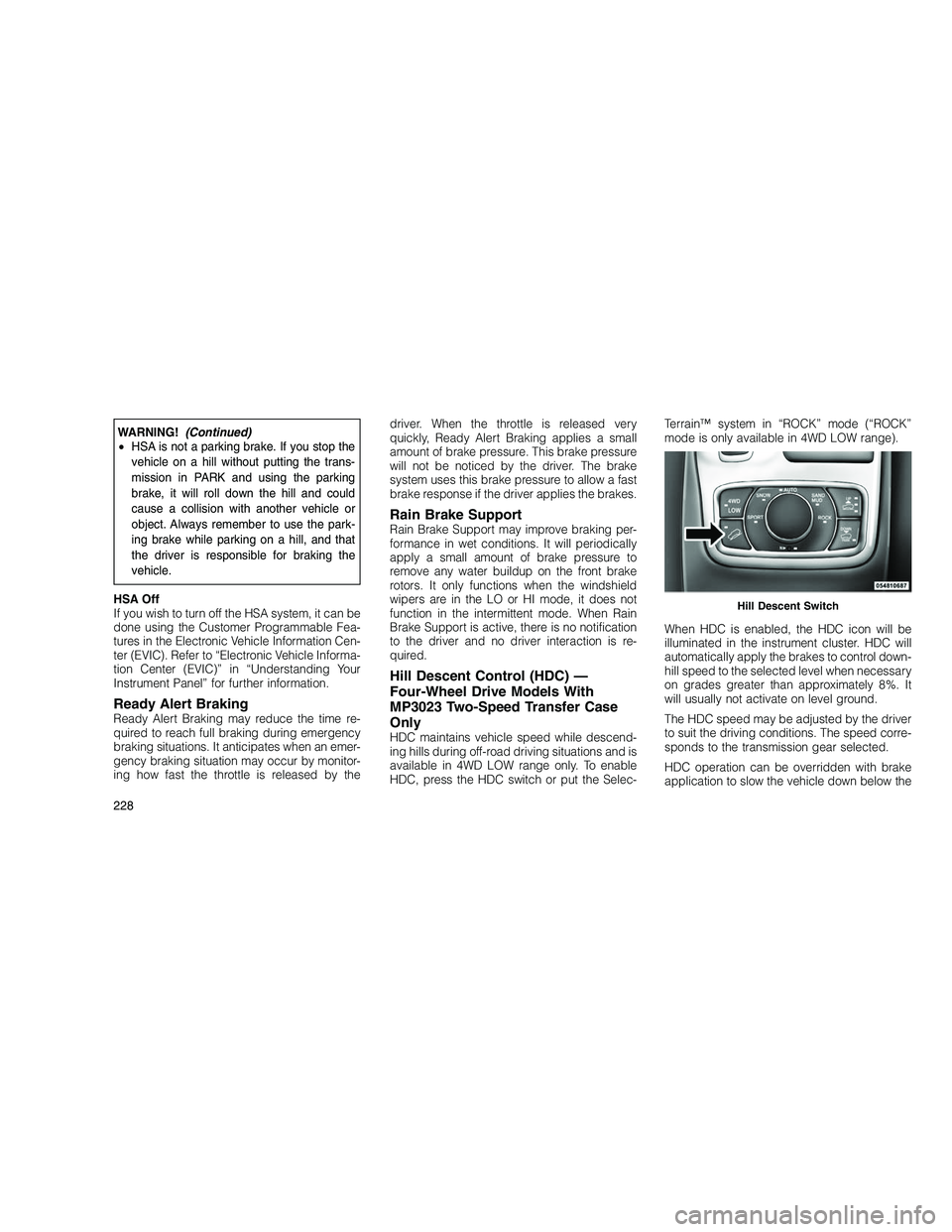
WARNING!(Continued)
• HSA is not a parking brake. If you stop the
vehicle on a hill without putting the trans-
mission in PARK and using the parking
brake, it will roll down the hill and could
cause a collision with another vehicle or
object. Always remember to use the park-
ing brake while parking on a hill, and that
the driver is responsible for braking the
vehicle.
HSA Off
If you wish to turn off the HSA system, it can be
done using the Customer Programmable Fea-
tures in the Electronic Vehicle Information Cen-
ter (EVIC). Refer to “Electronic Vehicle Informa-
tion Center (EVIC)” in “Understanding Your
Instrument Panel” for further information.
Ready Alert BrakingReady Alert Braking may reduce the time re-
quired to reach full braking during emergency
braking situations. It anticipates when an emer-
gency braking situation may occur by monitor-
ing how fast the throttle is released by the driver. When the throttle is released very
quickly, Ready Alert Braking applies a small
amount of brake pressure. This brake pressure
will not be noticed by the driver. The brake
system uses this brake pressure to allow a fast
brake response if the driver applies the brakes.
Rain Brake SupportRain Brake Support may improve braking per-
formance in wet conditions. It will periodically
apply a small amount of brake pressure to
remove any water buildup on the front brake
rotors. It only functions when the windshield
wipers are in the LO or HI mode, it does not
function in the intermittent mode. When Rain
Brake Support is active, there is no notification
to the driver and no driver interaction is re-
quired.
Hill Descent Control (HDC) —
Four-Wheel Drive Models With
MP3023 Two-Speed Transfer Case
Only
HDC maintains vehicle speed while descend-
ing hills during off-road driving situations and is
available in 4WD LOW range only. To enable
HDC, press the HDC switch or put the Selec-Terrain™ system in “ROCK” mode (“ROCK”
mode is only available in 4WD LOW range).
When HDC is enabled, the HDC icon will be
illuminated in the instrument cluster. HDC will
automatically apply the brakes to control down-
hill speed to the selected level when necessary
on grades greater than approximately 8%. It
will usually not activate on level ground.
The HDC speed may be adjusted by the driver
to suit the driving conditions. The speed corre-
sponds to the transmission gear selected.
HDC operation can be overridden with brake
application to slow the vehicle down below the
Hill Descent Switch
228
Page 233 of 350
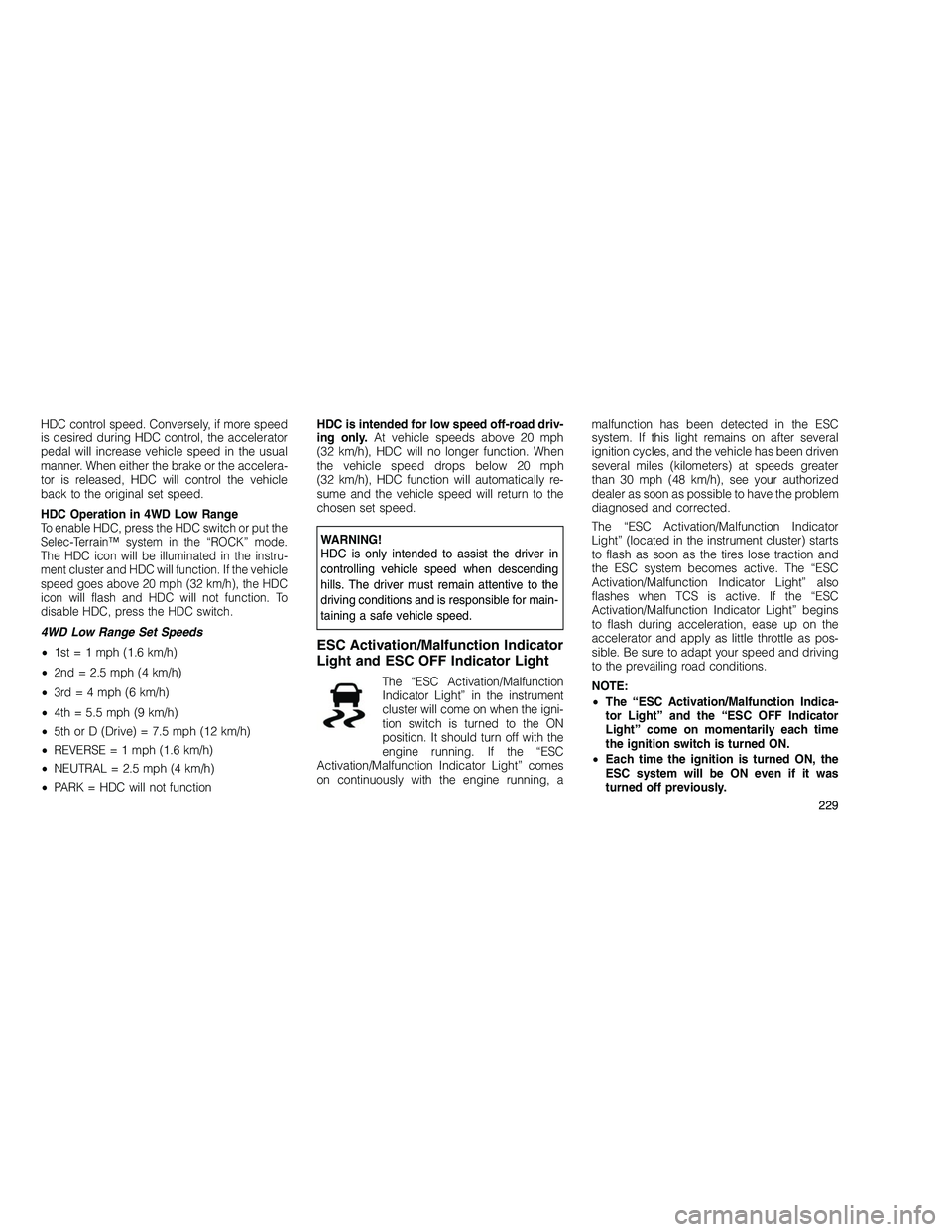
HDC control speed. Conversely, if more speed
is desired during HDC control, the accelerator
pedal will increase vehicle speed in the usual
manner. When either the brake or the accelera-
tor is released, HDC will control the vehicle
back to the original set speed.
HDC Operation in 4WD Low Range
To enable HDC, press the HDC switch or put the
Selec-Terrain™ system in the “ROCK” mode.
The HDC icon will be illuminated in the instru-
ment cluster and HDC will function. If the vehicle
speed goes above 20 mph (32 km/h), the HDC
icon will flash and HDC will not function. To
disable HDC, press the HDC switch.
4WD Low Range Set Speeds
•1st = 1 mph (1.6 km/h)
• 2nd = 2.5 mph (4 km/h)
• 3rd = 4 mph (6 km/h)
• 4th = 5.5 mph (9 km/h)
• 5th or D (Drive) = 7.5 mph (12 km/h)
• REVERS E = 1 mph (1.6 km/h)
• NEUTRAL = 2.5 mph (4 km/h)
• PARK = HDC will not function HDC is intended for low speed off-road driv-
ing only.
At vehicle speeds above 20 mph
(32 km/h), HDC will no longer function. When
the vehicle speed drops below 20 mph
(32 km/h), HDC function will automatically re-
sume and the vehicle speed will return to the
chosen set speed.
WARNING!
HDC is only intended to assist the driver in
controlling vehicle speed when descending
hills. The driver must remain attentive to the
driving conditions and is responsible for main-
taining a safe vehicle speed.
ESC Activation/Malfunction Indicator
Light and ESC OFF Indicator Light
The “ESC Activation/Malfunction
Indicator Light” in the instrument
cluster will come on when the igni-
tion switch is turned to the ON
position. It should turn off with the
engine running. If the “ESC
Activation/Malfunction Indicator Light” comes
on continuously with the engine running, a malfunction has been detected in the ESC
system. If this light remains on after several
ignition cycles, and the vehicle has been driven
several miles (kilometers) at speeds greater
than 30 mph (48 km/h), see your authorized
dealer as soon as possible to have the problem
diagnosed and corrected.
The “ESC Activation/Malfunction Indicator
Light” (located in the instrument cluster) starts
to flash as soon as the tires lose traction and
the ESC system becomes active. The “ESC
Activation/Malfunction Indicator Light” also
flashes when TCS is active. If the “ESC
Activation/Malfunction Indicator Light” begins
to flash during acceleration, ease up on the
accelerator and apply as little throttle as pos-
sible. Be sure to adapt your speed and driving
to the prevailing road conditions.
NOTE:
•
The “ESC Activation/Malfunction Indica-
tor Light” and the “ESC OFF Indicator
Light” come on momentarily each time
the ignition switch is turned ON.
• Each time the ignition is turned ON, the
ESC system will be ON even if it was
turned off previously.
229
Page 234 of 350
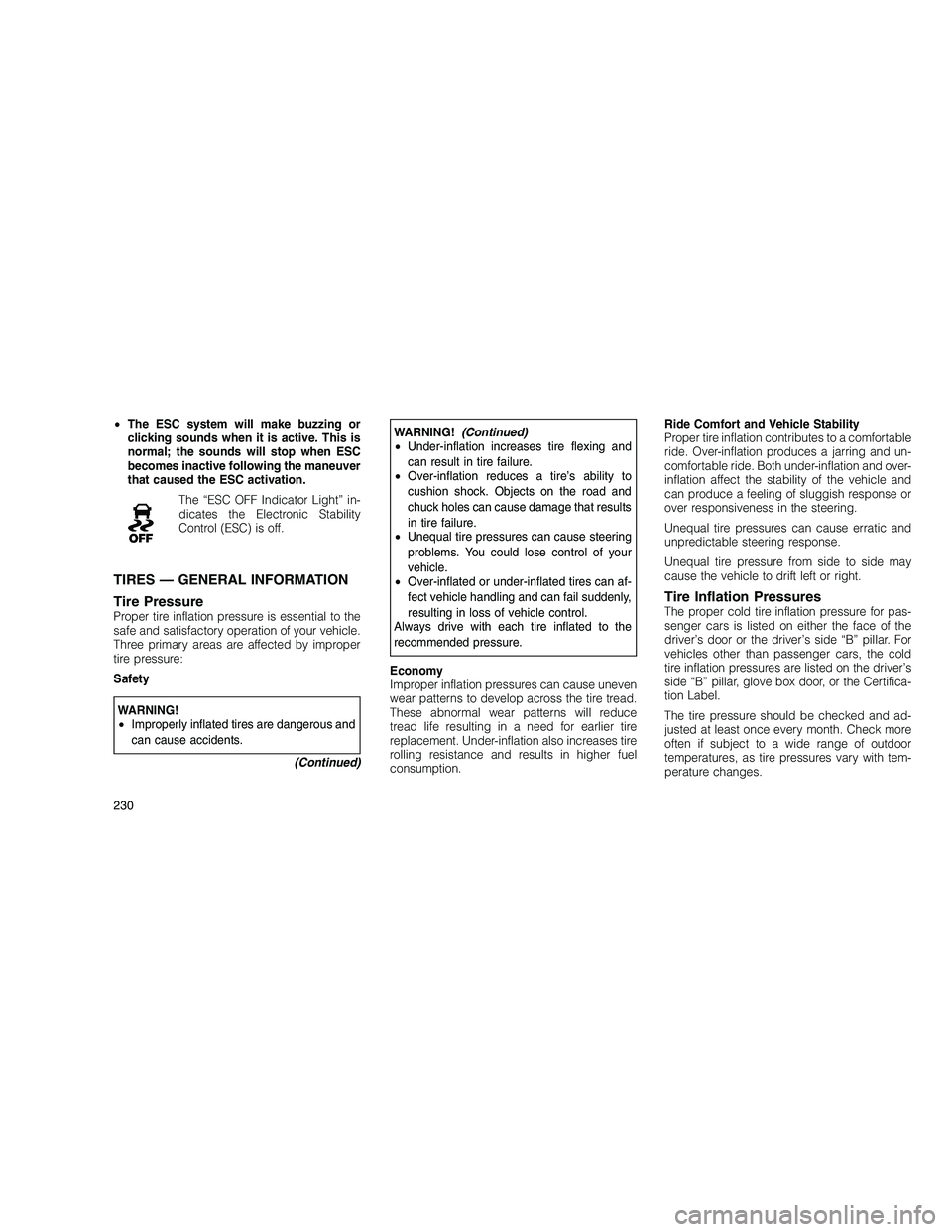
•The ESC system will make buzzing or
clicking sounds when it is active. This is
normal; the sounds will stop when ESC
becomes inactive following the maneuver
that caused the ESC activation.
The “ESC OFF Indicator Light” in-
dicates the Electronic Stability
Control (ESC) is off.
TIRES — GENERAL INFORMATION
Tire Pressure
Proper tire inflation pressure is essential to the
safe and satisfactory operation of your vehicle.
Three primary areas are affected by improper
tire pressure:
Safety
WARNING!
•Improperly inflated tires are dangerous and
can cause accidents.
(Continued)
WARNING!(Continued)
• Under-inflation increases tire flexing and
can result in tire failure.
• Over-inflation reduces a tire’s ability to
cushion shock. Objects on the road and
chuck holes can cause damage that results
in tire failure.
• Unequal tire pressures can cause steering
problems. You could lose control of your
vehicle.
• Over-inflated or under-inflated tires can af-
fect vehicle handling and can fail suddenly,
resulting in loss of vehicle control.
Always drive with each tire inflated to the
recommended pressure.
Economy
Improper inflation pressures can cause uneven
wear patterns to develop across the tire tread.
These abnormal wear patterns will reduce
tread life resulting in a need for earlier tire
replacement. Under-inflation also increases tire
rolling resistance and results in higher fuel
consumption. Ride Comfort and Vehicle Stability
Proper tire inflation contributes to a comfortable
ride. Over-inflation produces a jarring and un-
comfortable ride. Both under-inflation and over-
inflation affect the stability of the vehicle and
can produce a feeling of sluggish response or
over responsiveness in the steering.
Unequal tire pressures can cause erratic and
unpredictable steering response.
Unequal tire pressure from side to side may
cause the vehicle to drift left or right.
Tire Inflation PressuresThe proper cold tire inflation pressure for pas-
senger cars is listed on either the face of the
driver’s door or the driver’s side “B” pillar. For
vehicles other than passenger cars, the cold
tire inflation pressures are listed on the driver’s
side “B” pillar, glove box door, or the Certifica-
tion Label.
The tire pressure should be checked and ad-
justed at least once every month. Check more
often if subject to a wide range of outdoor
temperatures, as tire pressures vary with tem-
perature changes.
230
Page 235 of 350
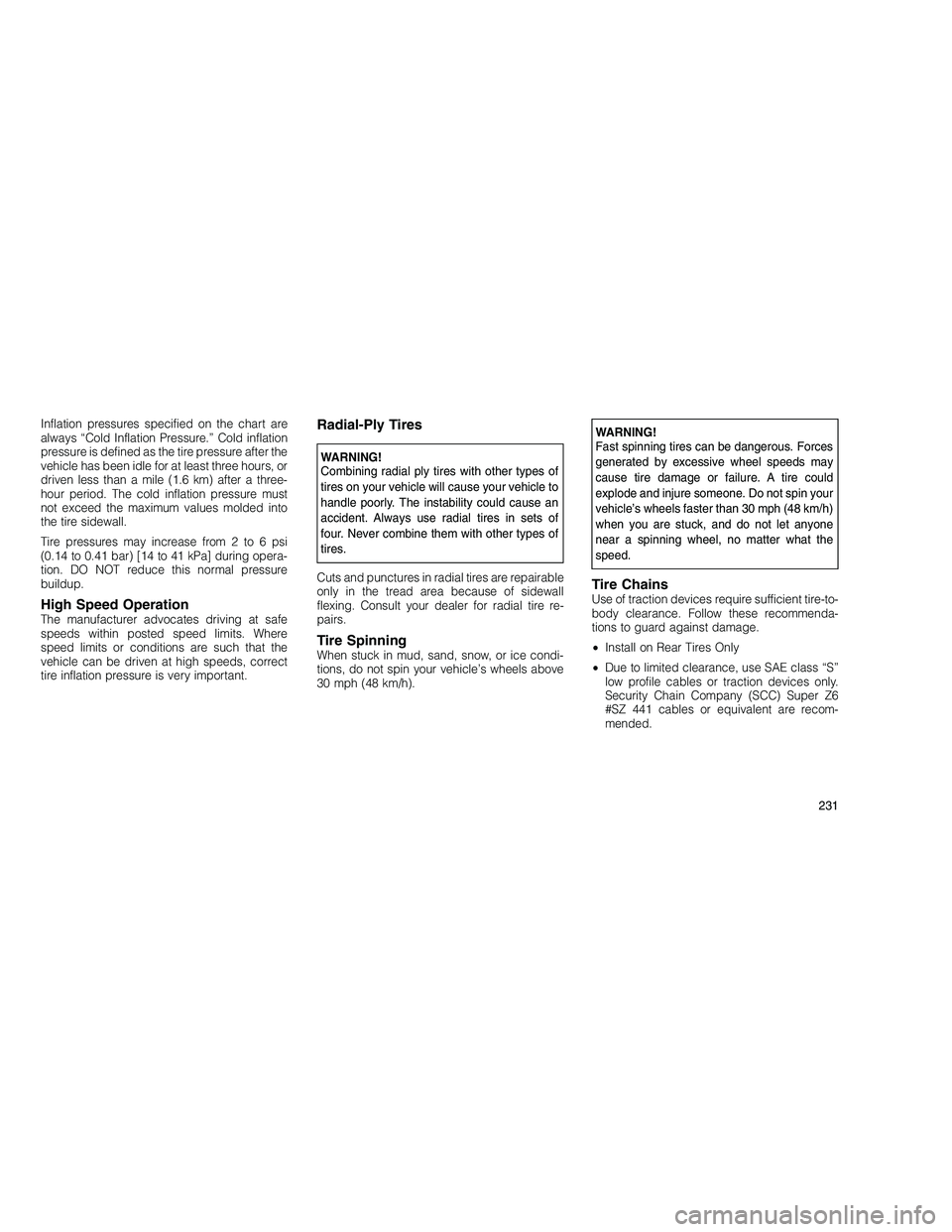
Inflation pressures specified on the chart are
always “Cold Inflation Pressure.” Cold inflation
pressure is defined as the tire pressure after the
vehicle has been idle for at least three hours, or
driven less than a mile (1.6 km) after a three-
hour period. The cold inflation pressure must
not exceed the maximum values molded into
the tire sidewall.
Tire pressures may increase from 2 to 6 psi
(0.14 to 0.41 bar) [14 to 41 kPa] during opera-
tion. DO NOT reduce this normal pressure
buildup.
High Speed OperationThe manufacturer advocates driving at safe
speeds within posted speed limits. Where
speed limits or conditions are such that the
vehicle can be driven at high speeds, correct
tire inflation pressure is very important.
Radial-Ply Tires
WARNING!
Combining radial ply tires with other types of
tires on your vehicle will cause your vehicle to
handle poorly. The instability could cause an
accident. Always use radial tires in sets of
four. Never combine them with other types of
tires.
Cuts and punctures in radial tires are repairable
only in the tread area because of sidewall
flexing. Consult your dealer for radial tire re-
pairs.
Tire SpinningWhen stuck in mud, sand, snow, or ice condi-
tions, do not spin your vehicle’s wheels above
30 mph (48 km/h).
WARNING!
Fast spinning tires can be dangerous. Forces
generated by excessive wheel speeds may
cause tire damage or failure. A tire could
explode and injure someone. Do not spin your
vehicle’s wheels faster than 30 mph (48 km/h)
when you are stuck, and do not let anyone
near a spinning wheel, no matter what the
speed.
Tire ChainsUse of traction devices require sufficient tire-to-
body clearance. Follow these recommenda-
tions to guard against damage.
• Install on Rear Tires Only
• Due to limited clearance, use SAE class “S”
low profile cables or traction devices only.
Security Chain Company (SCC) Super Z6
#SZ 441 cables or equivalent are recom-
mended.
231
Page 236 of 350
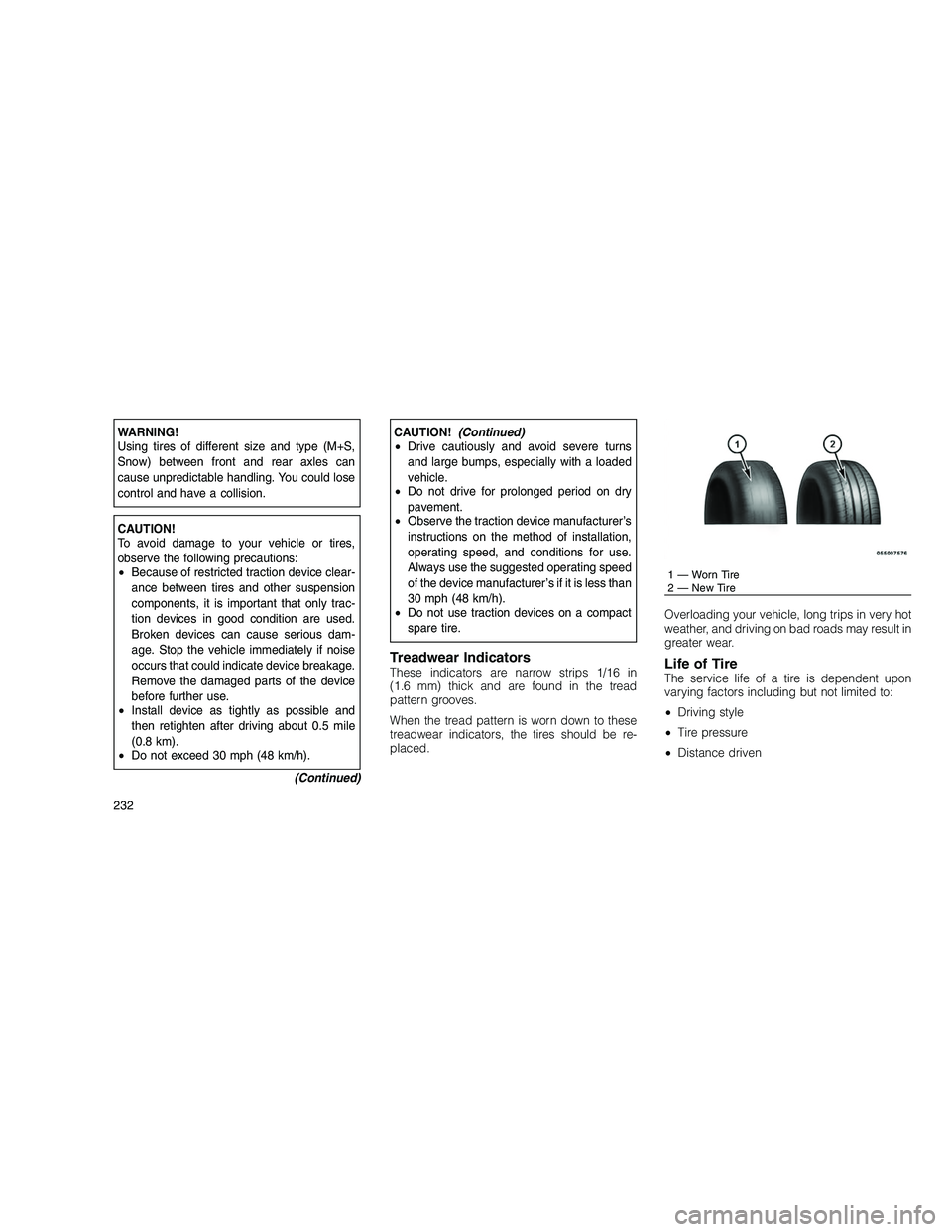
WARNING!
Using tires of different size and type (M+S,
Snow) between front and rear axles can
cause unpredictable handling. You could lose
control and have a collision.
CAUTION!
To avoid damage to your vehicle or tires,
observe the following precautions:
•Because of restricted traction device clear-
ance between tires and other suspension
components, it is important that only trac-
tion devices in good condition are used.
Broken devices can cause serious dam-
age. Stop the vehicle immediately if noise
occurs that could indicate device breakage.
Remove the damaged parts of the device
before further use.
• Install device as tightly as possible and
then retighten after driving about 0.5 mile
(0.8 km).
• Do not exceed 30 mph (48 km/h).
(Continued)
CAUTION!(Continued)
• Drive cautiously and avoid severe turns
and large bumps, especially with a loaded
vehicle.
• Do not drive for prolonged period on dry
pavement.
• Observe the traction device manufacturer’s
instructions on the method of installation,
operating speed, and conditions for use.
Always use the suggested operating speed
of the device manufacturer’s if it is less than
30 mph (48 km/h).
• Do not use traction devices on a compact
spare tire.
Treadwear IndicatorsThese indicators are narrow strips 1/16 in
(1.6 mm) thick and are found in the tread
pattern grooves.
When the tread pattern is worn down to these
treadwear indicators, the tires should be re-
placed. Overloading your vehicle, long trips in very hot
weather, and driving on bad roads may result in
greater wear.Life of TireThe service life of a tire is dependent upon
varying factors including but not limited to:
•
Driving style
• Tire pressure
• Distance driven
1 — Worn Tire
2 — New Tire
232
Page 237 of 350
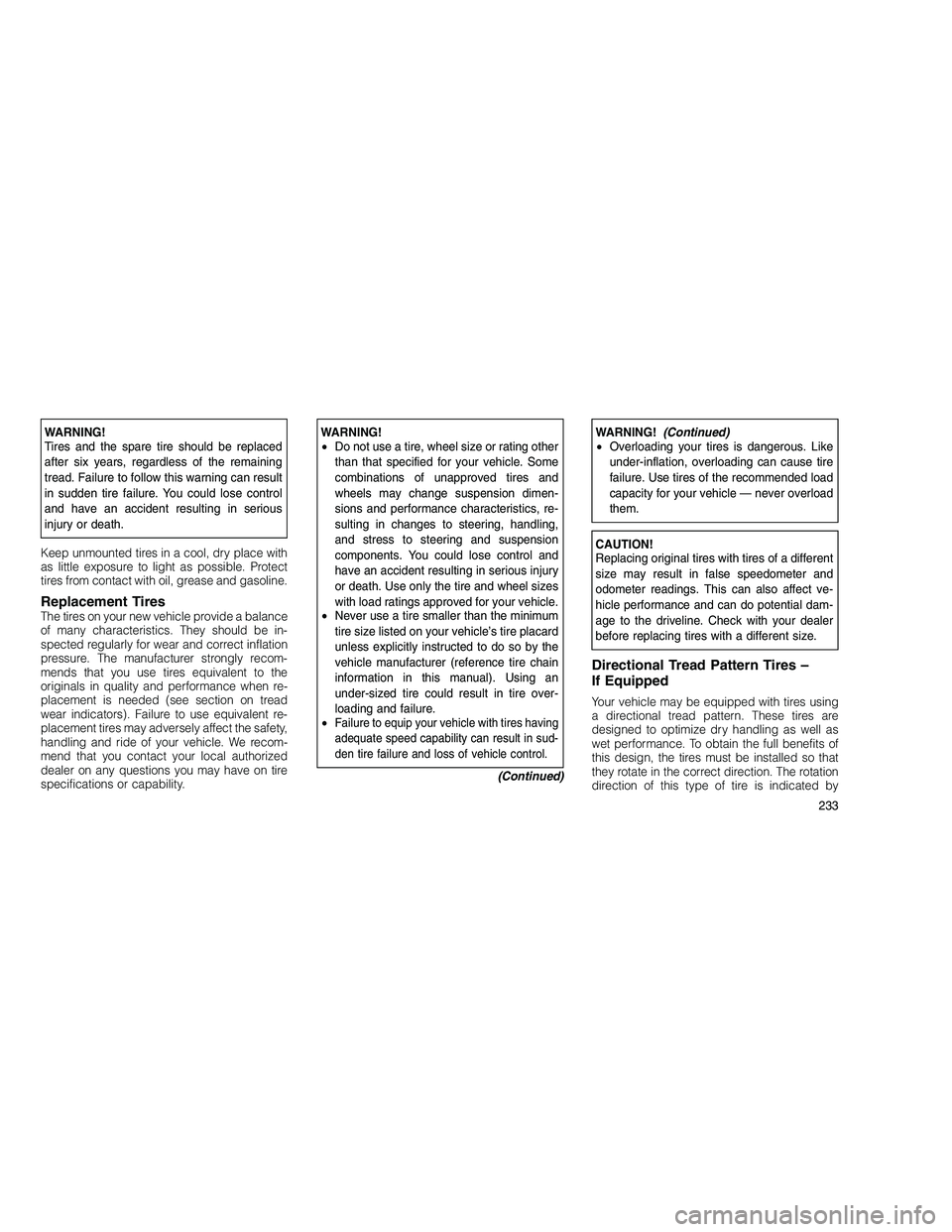
WARNING!
Tires and the spare tire should be replaced
after six years, regardless of the remaining
tread. Failure to follow this warning can result
in sudden tire failure. You could lose control
and have an accident resulting in serious
injury or death.
Keep unmounted tires in a cool, dry place with
as little exposure to light as possible. Protect
tires from contact with oil, grease and gasoline.
Replacement TiresThe tires on your new vehicle provide a balance
of many characteristics. They should be in-
spected regularly for wear and correct inflation
pressure. The manufacturer strongly recom-
mends that you use tires equivalent to the
originals in quality and performance when re-
placement is needed (see section on tread
wear indicators). Failure to use equivalent re-
placement tires may adversely affect the safety,
handling and ride of your vehicle. We recom-
mend that you contact your local authorized
dealer on any questions you may have on tire
specifications or capability.
WARNING!
• Do not use a tire, wheel size or rating other
than that specified for your vehicle. Some
combinations of unapproved tires and
wheels may change suspension dimen-
sions and performance characteristics, re-
sulting in changes to steering, handling,
and stress to steering and suspension
components. You could lose control and
have an accident resulting in serious injury
or death. Use only the tire and wheel sizes
with load ratings approved for your vehicle.
• Never use a tire smaller than the minimum
tire size listed on your vehicle’s tire placard
unless explicitly instructed to do so by the
vehicle manufacturer (reference tire chain
information in this manual). Using an
under-sized tire could result in tire over-
loading and failure.
•
Failure to equip your vehicle with tires having
adequate speed capability can result in sud-
den tire failure and loss of vehicle control.
(Continued)
WARNING! (Continued)
• Overloading your tires is dangerous. Like
under-inflation, overloading can cause tire
failure. Use tires of the recommended load
capacity for your vehicle — never overload
them.
CAUTION!
Replacing original tires with tires of a different
size may result in false speedometer and
odometer readings. This can also affect ve-
hicle performance and can do potential dam-
age to the driveline. Check with your dealer
before replacing tires with a different size.
Directional Tread Pattern Tires –
If Equipped
Your vehicle may be equipped with tires using
a directional tread pattern. These tires are
designed to optimize dry handling as well as
wet performance. To obtain the full benefits of
this design, the tires must be installed so that
they rotate in the correct direction. The rotation
direction of this type of tire is indicated by
233
Page 238 of 350
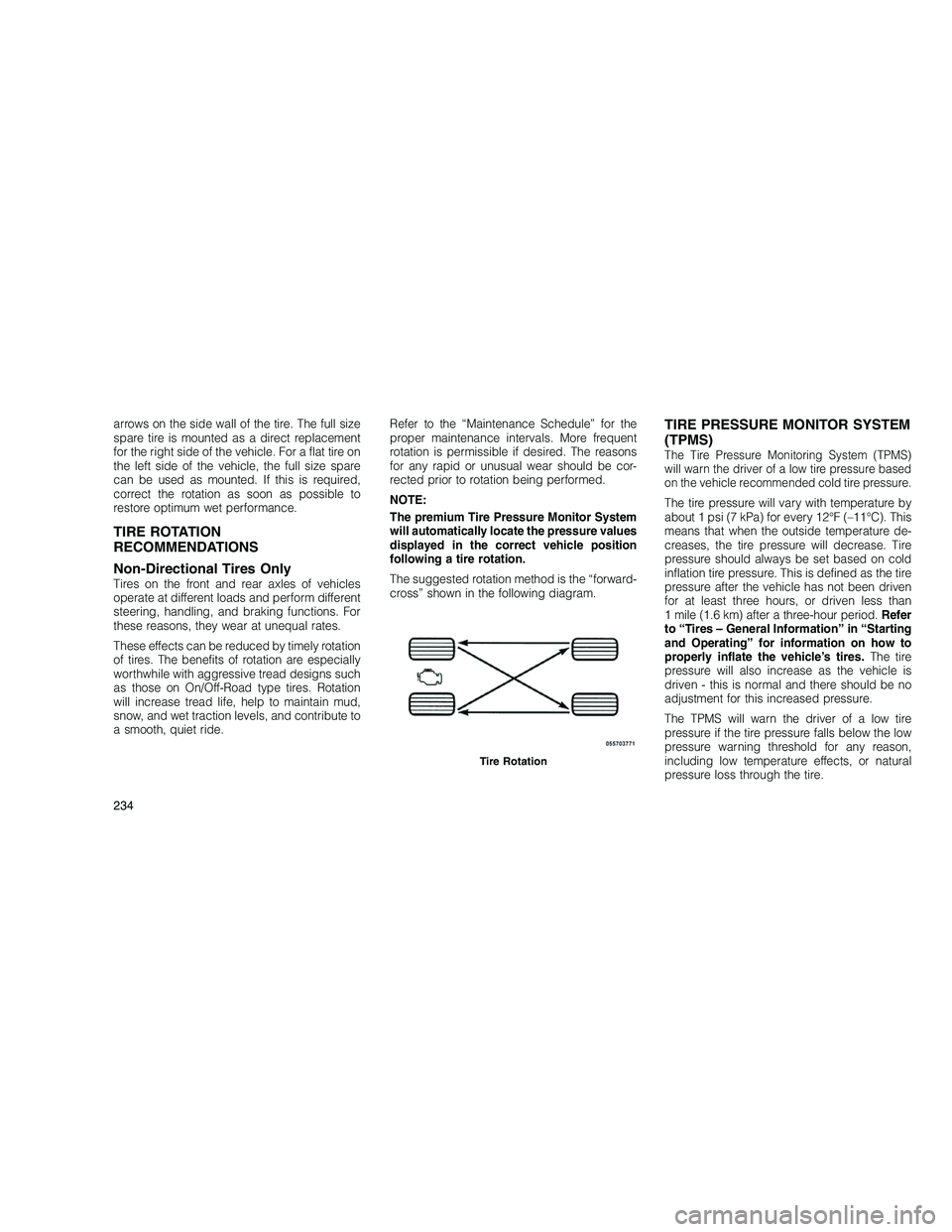
arrows on the side wall of the tire. The full size
spare tire is mounted as a direct replacement
for the right side of the vehicle. For a flat tire on
the left side of the vehicle, the full size spare
can be used as mounted. If this is required,
correct the rotation as soon as possible to
restore optimum wet performance.
TIRE ROTATION
RECOMMENDATIONS
Non-Directional Tires Only
Tires on the front and rear axles of vehicles
operate at different loads and perform different
steering, handling, and braking functions. For
these reasons, they wear at unequal rates.
These effects can be reduced by timely rotation
of tires. The benefits of rotation are especially
worthwhile with aggressive tread designs such
as those on On/Off-Road type tires. Rotation
will increase tread life, help to maintain mud,
snow, and wet traction levels, and contribute to
a smooth, quiet ride.Refer to the “Maintenance Schedule” for the
proper maintenance intervals. More frequent
rotation is permissible if desired. The reasons
for any rapid or unusual wear should be cor-
rected prior to rotation being performed.
NOTE:
The premium Tire Pressure Monitor System
will automatically locate the pressure values
displayed in the correct vehicle position
following a tire rotation.
The suggested rotation method is the “forward-
cross” shown in the following diagram.
TIRE PRESSURE MONITOR SYSTEM
(TPMS)
The Tire Pressure Monitoring System (TPMS)
will warn the driver of a low tire pressure based
on the vehicle recommended cold tire pressure.
The tire pressure will vary with temperature by
about 1 psi (7 kPa) for every 12°F (–11°C). This
means that when the outside temperature de-
creases, the tire pressure will decrease. Tire
pressure should always be set based on cold
inflation tire pressure. This is defined as the tire
pressure after the vehicle has not been driven
for at least three hours, or driven less than
1 mile (1.6 km) after a three-hour period.
Refer
to “Tires – General Information” in “Starting
and Operating” for information on how to
properly inflate the vehicle’s tires. The tire
pressure will also increase as the vehicle is
driven - this is normal and there should be no
adjustment for this increased pressure.
The TPMS will warn the driver of a low tire
pressure if the tire pressure falls below the low
pressure warning threshold for any reason,
including low temperature effects, or natural
pressure loss through the tire.
Tire Rotation
234
Page 239 of 350
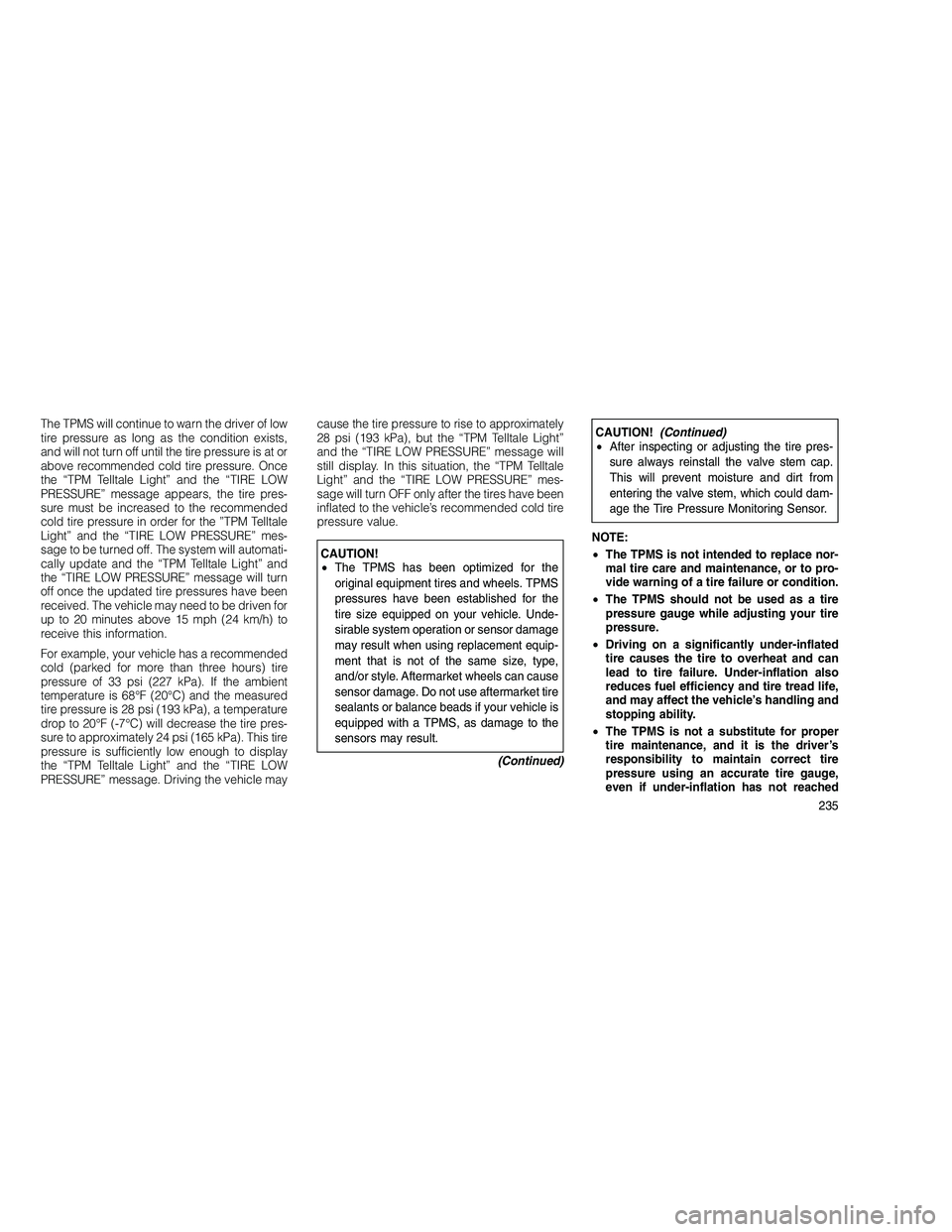
The TPMS will continue to warn the driver of low
tire pressure as long as the condition exists,
and will not turn off until the tire pressure is at or
above recommended cold tire pressure. Once
the “TPM Telltale Light” and the “TIRE LOW
PRESSURE” message appears, the tire pres-
sure must be increased to the recommended
cold tire pressure in order for the ”TPM Telltale
Light” and the “TIRE LOW PRESSURE” mes-
sage to be turned off. The system will automati-
cally update and the “TPM Telltale Light” and
the “TIRE LOW PRESSURE” message will turn
off once the updated tire pressures have been
received. The vehicle may need to be driven for
up to 20 minutes above 15 mph (24 km/h) to
receive this information.
For example, your vehicle has a recommended
cold (parked for more than three hours) tire
pressure of 33 psi (227 kPa). If the ambient
temperature is 68°F (20°C) and the measured
tire pressure is 28 psi (193 kPa), a temperature
drop to 20°F (-7°C) will decrease the tire pres-
sure to approximately 24 psi (165 kPa). This tire
pressure is sufficiently low enough to display
the “TPM Telltale Light” and the “TIRE LOW
PRESSURE” message. Driving the vehicle maycause the tire pressure to rise to approximately
28 psi (193 kPa), but the “TPM Telltale Light”
and the “TIRE LOW PRESSURE” message will
still display. In this situation, the “TPM Telltale
Light” and the “TIRE LOW PRESSURE” mes-
sage will turn OFF only after the tires have been
inflated to the vehicle’s recommended cold tire
pressure value.
CAUTION!
•
The TPMS has been optimized for the
original equipment tires and wheels. TPMS
pressures have been established for the
tire size equipped on your vehicle. Unde-
sirable system operation or sensor damage
may result when using replacement equip-
ment that is not of the same size, type,
and/or style. Aftermarket wheels can cause
sensor damage. Do not use aftermarket tire
sealants or balance beads if your vehicle is
equipped with a TPMS, as damage to the
sensors may result.
(Continued)
CAUTION!(Continued)
• After inspecting or adjusting the tire pres-
sure always reinstall the valve stem cap.
This will prevent moisture and dirt from
entering the valve stem, which could dam-
age the Tire Pressure Monitoring Sensor.
NOTE:
• The TPMS is not intended to replace nor-
mal tire care and maintenance, or to pro-
vide warning of a tire failure or condition.
• The TPMS should not be used as a tire
pressure gauge while adjusting your tire
pressure.
• Driving on a significantly under-inflated
tire causes the tire to overheat and can
lead to tire failure. Under-inflation also
reduces fuel efficiency and tire tread life,
and may affect the vehicle’s handling and
stopping ability.
• The TPMS is not a substitute for proper
tire maintenance, and it is the driver’s
responsibility to maintain correct tire
pressure using an accurate tire gauge,
even if under-inflation has not reached
235
Page 240 of 350
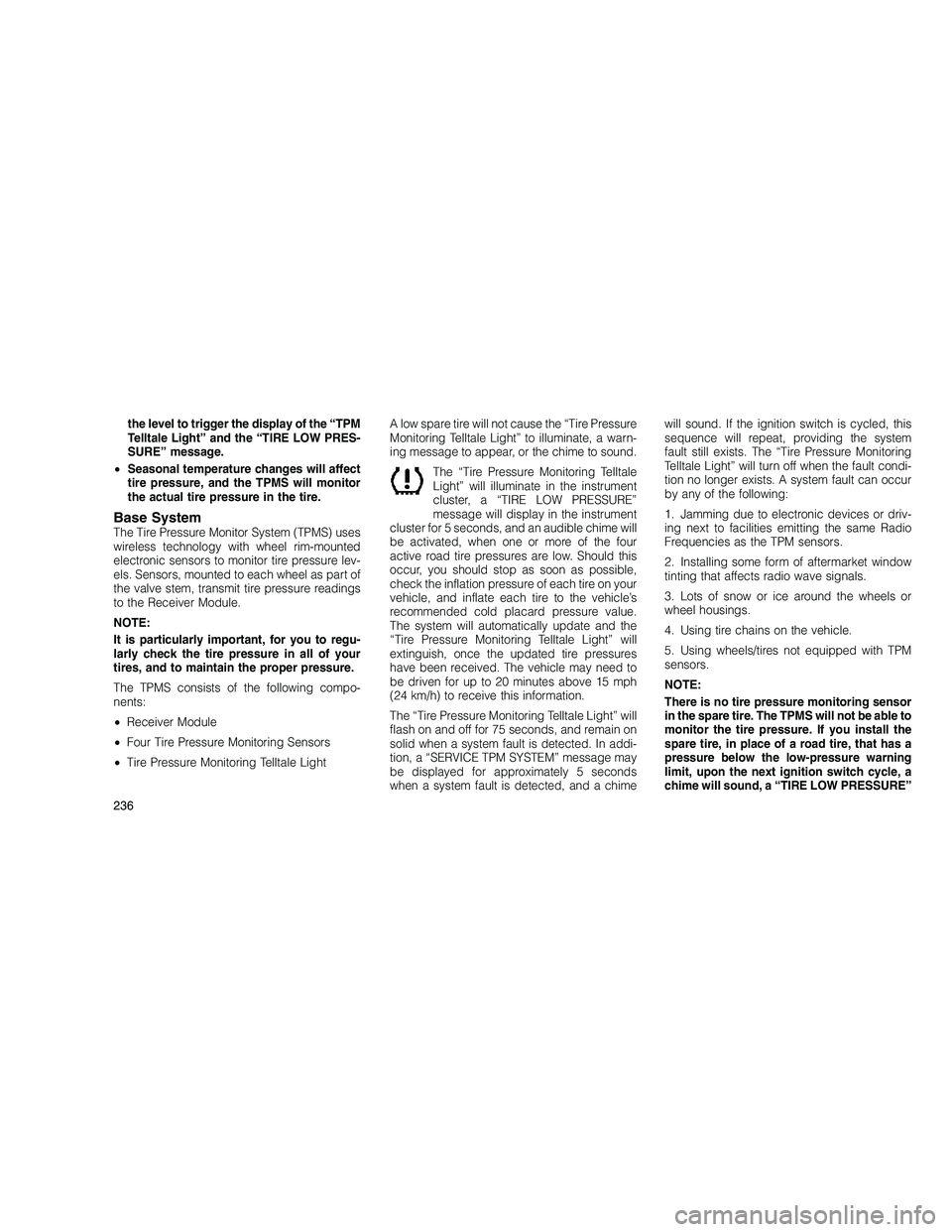
the level to trigger the display of the “TPM
Telltale Light” and the “TIRE LOW PRES-
SURE” message.
• Seasonal temperature changes will affect
tire pressure, and the TPMS will monitor
the actual tire pressure in the tire.
Base SystemThe Tire Pressure Monitor System (TPMS) uses
wireless technology with wheel rim-mounted
electronic sensors to monitor tire pressure lev-
els. Sensors, mounted to each wheel as part of
the valve stem, transmit tire pressure readings
to the Receiver Module.
NOTE:
It is particularly important, for you to regu-
larly check the tire pressure in all of your
tires, and to maintain the proper pressure.
The TPMS consists of the following compo-
nents:
• Receiver Module
• Four Tire Pressure Monitoring Sensors
• Tire Pressure Monitoring Telltale Light A low spare tire will not cause the “Tire Pressure
Monitoring Telltale Light” to illuminate, a warn-
ing message to appear, or the chime to sound.
The “Tire Pressure Monitoring Telltale
Light” will illuminate in the instrument
cluster, a “TIRE LOW PRESSURE”
message will display in the instrument
cluster for 5 seconds, and an audible chime will
be activated, when one or more of the four
active road tire pressures are low. Should this
occur, you should stop as soon as possible,
check the inflation pressure of each tire on your
vehicle, and inflate each tire to the vehicle’s
recommended cold placard pressure value.
The system will automatically update and the
“Tire Pressure Monitoring Telltale Light” will
extinguish, once the updated tire pressures
have been received. The vehicle may need to
be driven for up to 20 minutes above 15 mph
(24 km/h) to receive this information.
The “Tire Pressure Monitoring Telltale Light” will
flash on and off for 75 seconds, and remain on
solid when a system fault is detected. In addi-
tion, a “SERVICE TPM SYSTEM” message may
be displayed for approximately 5 seconds
when a system fault is detected, and a chime will sound. If the ignition switch is cycled, this
sequence will repeat, providing the system
fault still exists. The “Tire Pressure Monitoring
Telltale Light” will turn off when the fault condi-
tion no longer exists. A system fault can occur
by any of the following:
1. Jamming due to electronic devices or driv-
ing next to facilities emitting the same Radio
Frequencies as the TPM sensors.
2. Installing some form of aftermarket window
tinting that affects radio wave signals.
3. Lots of snow or ice around the wheels or
wheel housings.
4. Using tire chains on the vehicle.
5. Using wheels/tires not equipped with TPM
sensors.
NOTE:
There is no tire pressure monitoring sensor
in the spare tire. The TPMS will not be able to
monitor the tire pressure. If you install the
spare tire, in place of a road tire, that has a
pressure below the low-pressure warning
limit, upon the next ignition switch cycle, a
chime will sound, a “TIRE LOW PRESSURE”
236